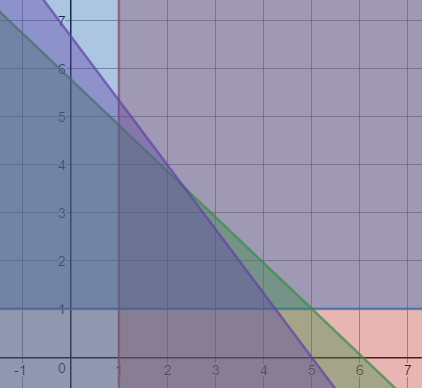Find the constraints, make a plot, find the maximum number of attendants, and compute the minimum cost solution for the problem below? Also, show that #4x+3y<=20# and #99x + 104y <= 600# are two of the constraints.
William is a clothing maker, and his sister is getting married. He has agreed to make the suits and dresses for all the pageboys and bridesmaids, as long as he doesn't work more than 100 hours. It takes him 20 hours to make one dress and 15 hours to make one suit. Her sister has a budget of ₤600, and fabric costs ₤8/m. A dress needs 8m of fabric, while a suit needs 3m of fabric. He charges an additional ₤35 to make a dress and an extra ₤80 for making each suit.
William is a clothing maker, and his sister is getting married. He has agreed to make the suits and dresses for all the pageboys and bridesmaids, as long as he doesn't work more than 100 hours. It takes him 20 hours to make one dress and 15 hours to make one suit. Her sister has a budget of ₤600, and fabric costs ₤8/m. A dress needs 8m of fabric, while a suit needs 3m of fabric. He charges an additional ₤35 to make a dress and an extra ₤80 for making each suit.
1 Answer
Constraints:
#4x+3y <= 20#
#99x+104y<= 600#
#x>= 1#
#y>=1#
See explanation for plot.
Maximum number of attendants: 5.
Minimum cost solution is 1 bridesmaid and 4 pageboys.
Explanation:
To help this make more sense, let's think of
Let's start with the time restriction. We can't go over 100 hours, and if it takes 20 hours to make a dress and 15 hours to make a suit, then we get the following constraint:
#["20 hr"/"dress" times x " dresses"]+["15 hr"/"suit" times y " suits"] <= "100 hours"#
What does this mean? If William plans to make
#20x+15y<=100#
which reduces to
#4x+3y <= 20#
which is the first constraint we were asked to show.
What's another "limit" we need to stay under? The cost. William can't spend more than ₤600 on all the outfits. So, how much does it cost to make each outfit?
For a dress, the cost is
#["8m fabric"/"dress" times "₤8"/"1m fabric"]+"₤35 (extra cost)"/"dress"#
#=" ""₤64"/"dress"" "+" ""₤35"/"dress"#
#=" ₤99/dress"#
Likewise, for a suit, the cost is
#["3m"/"suit" times "₤8"/"m"]+"₤80"/"suit"" "=" ""₤104/suit"#
So, if he wants to make
#["₤99"/"dress" times x " dresses"]+["₤104"/"suit" times y " suits"] <= "₤600"#
or
#99x+104y<= 600#
The other two constraints are given to us verbatim in the question: we must have at least 1 bridesmaid (and thus at least 1 dress) and at least 1 pageboy (meaning at least 1 suit). These are written as
#x>= 1" "# and#" "y>=1# .
To plot the region of acceptable values for

The acceptable region for
The maximum number of attendants is the largest sum of
William's sister pays him for his materials and his time, so her overall cost for each dress is
#"₤99 in materials " + ["₤15"/"hour" times "20 hours"]#
#=₤99+₤300#
#=₤399#
and her overall cost for each suit is
#"₤104 in materials " + ["₤15"/"hour" times "15 hours"]#
#=₤104+₤225#
#=₤329#
So we want to minimize the expression
This is easy enough: since the overall cost for a suit is less than that for a dress, we want to minimize the number of dresses we order (to minimize the cost). Thus, the minimum cost solution is

